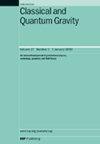波西米亚力学与量子引力有效作用的推广
IF 3.7
3区 物理与天体物理
Q2 ASTRONOMY & ASTROPHYSICS
引用次数: 0
摘要
我们利用量子引力理论的有效作用(EA)将量子力学的德布罗意-玻姆(dBB)公式推广到量子引力(QG)的情况。这是通过将dBB运动方程(EOM)替换为EA EOM来实现的,即使在非引力情况下,这也是有益的,因为这样可以避免违反海森堡不确定性关系和静止束缚态经典轨迹的缺失。EA形式化的另一个优点是可以在量子场论(QFT)的情况下获得场的构型。提出的QG推广对于波米亚力学来说是很自然的,因为dBB波函数实际上是宇宙的波函数,为了定义任意初始状态的EA,需要一个QG路径积分。QG EA可以用分段平坦QG (PFQG)理论来构造,PFQG EA可以用与物质耦合的广义相对论的QFT EA来近似,截断点由时空三角测量的平均边长决定。然后我们可以计算相应的场构型,从这些场构型中我们可以得到相应基本粒子的轨迹。本文章由计算机程序翻译,如有差异,请以英文原文为准。
Generalization of Bohmian mechanics and quantum gravity effective action
We generalize the de Broglie–Bohm (dBB) formulation of quantum mechanics to the case of quantum gravity (QG) by using the effective action (EA) for a QG theory. This is done by replacing the dBB equations of motion (EOM) with the EA EOM, which is beneficial even in the non-gravitational case, since in this way one avoids the violations of the Heisenberg uncertainty relations and the absence of the classical trajectories for stationary bound states. Another advantage of the EA formalism is that one can obtain the field configurations in the case of a quantum field theory (QFT). The proposed QG generalization is natural for Bohmiam mechanics because a dBB wavefunction is really a wavefunction of the Universe and in order to define the EA for an arbitrary initial state one needs a QG path integral. The QG EA can be constructed by using the piecewise flat QG (PFQG) theory and the PFQG EA can be approximated by the QFT EA for General Relativity coupled to matter, with a cutoff determined by the average edge length of the spacetime triangulation. One can then calculate the corresponding field configurations and from these field configurations one can obtain the trajectories for the corresponding elementary particles.
求助全文
通过发布文献求助,成功后即可免费获取论文全文。
去求助
来源期刊

Classical and Quantum Gravity
物理-天文与天体物理
CiteScore
7.00
自引率
8.60%
发文量
301
审稿时长
2-4 weeks
期刊介绍:
Classical and Quantum Gravity is an established journal for physicists, mathematicians and cosmologists in the fields of gravitation and the theory of spacetime. The journal is now the acknowledged world leader in classical relativity and all areas of quantum gravity.
 求助内容:
求助内容: 应助结果提醒方式:
应助结果提醒方式:


